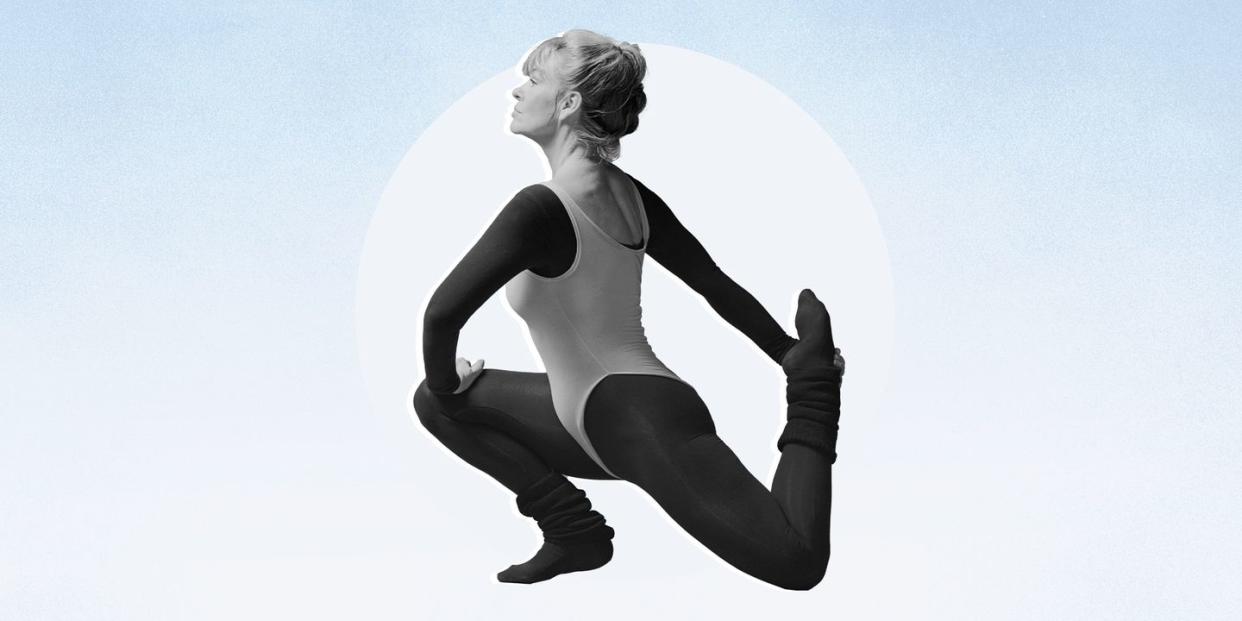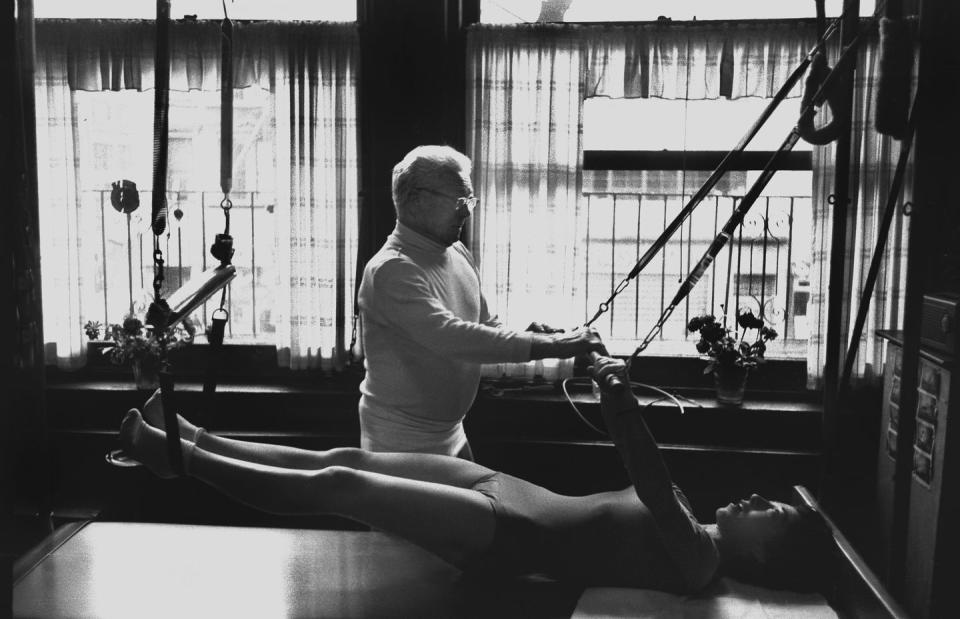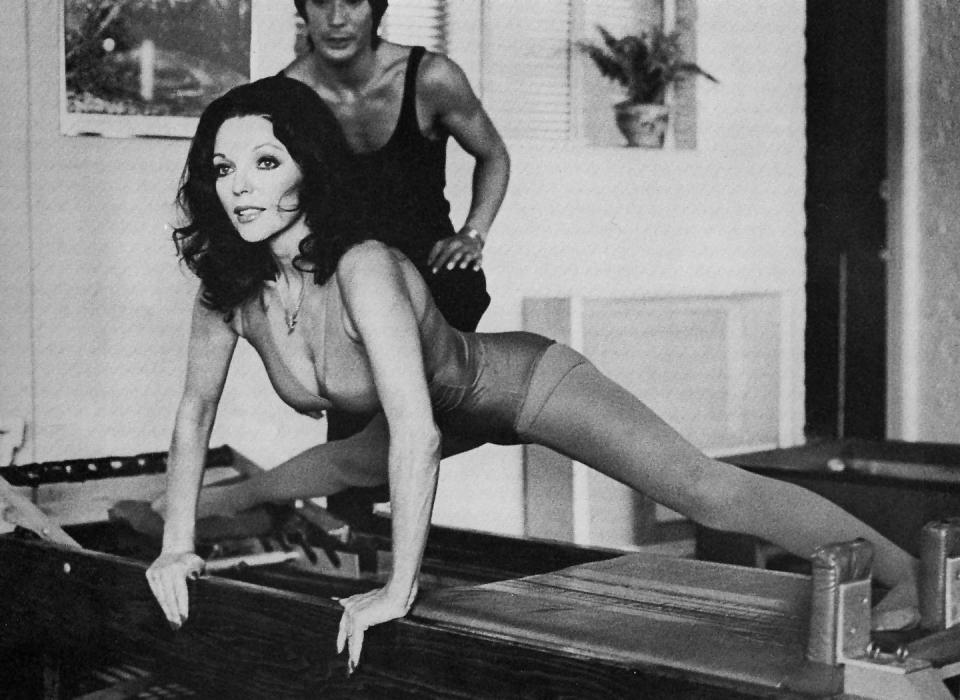Pilates Is Known as the Workout of Choice for Rich Moms, But Does That Totally Miss the Point?

- Oops!Something went wrong.Please try again later.
"I never understood that," Amy Nelms, the owner of the private studio Flatiron Pilates, whose clients include Lily Allen, Emma Corrin, and Jodie Comer, says when asked why people think of pilates as the rich woman's workout. "Pilates was invented by a man—and many men do pilates."
Nevertheless, the low-impact mind-body physical training methodology, which was invented by Joseph Pilates in the early 20th century as a means of injury rehabilitation and prevention for dancers, has never been more popular as the status workout of the well-to-do and just about every TikTok girly on the Internet. As Nelms puts it: pilates is for everybody and every body. Not just for rich women, as the Internet would suggest. The trick is to figure out how the practice can most benefit you.
The touted merits of the century-old workout are plentiful. With a regular practice of meticulously developed and detailed (though small) movements, one can increase flexibility, improve balance and core strength (as well as total body strengthening), enhance endurance and athletic performance, boost concentration and focus, and perhaps most crucially for the desk jockeys amongst us: better posture. So it is no wonder that the pilates is popular.
Throw a pandemic into the mix, with a population of housebound people cluing in to their physical health, and you have the makings of an exercise renaissance. "By necessity, there was a tremendous expansion, of remote fitness options available. So pilates became much more accessible," Nelms explains, noting that perhaps most importantly, there was a shift in attitudes about working out during that time. "People started to seek a more holistic approach to fitness, which has only continued. More and more people have come to understand the importance of incorporating core strength and flexibility training into their workout programs, in the hopes of preventing injury."

But anyone who has stepped foot into a pilates studio may have asked themselves,"Am I doing this correctly?" For Nelms, a good practice starts with understanding the methodology and not being overambitious. "The best way to implement pilates into your daily life is to start with a few basic mat exercises. Remember, basic does not mean easy," she says. "Pilates is an organized method with a system of exercises that follow progressions," she continues. Central to the methodology is this: work the smaller muscles in the body to prevent injury and combat the overdevelopment of certain muscles, which can happen from repetitive motions (or lack thereof). Think: overly tight shoulders or hips, from sitting or slumping, for example.
Choosing where you are going to learn the method is crucial. Blossom Leilani Crawford, the owner of Bridge Pilates in Brooklyn who also offers workshops for pilates professionals, explains that it's not just your instructor that matters, but also the venue. Of course, finding a fully certified teacher is a necessity, but Crawford adds, "You want to know how many hours of training it took to get that certificate. Some certifications can be done in a weekend—and not on equipment." The pro also notes that it's important to look at yourself too, and in particular, your goals. "If you have a very specific goal, a large class might not be the best place for you to work on it. Consider asking an instructor whether what you are aiming for can be achieved in a group class."
Additionally, Nelms suggests that if you are new to pilates, and it's an option for you, try to take a private lesson before a group class so as to figure out how to work toward your specific goal while in a group setting. This can help you drill down on an ideal outcome. Maybe you want to strengthen your upper back to combat the painful effects of bad posture, or maybe you need to strengthen your glutes and hamstrings to take the strain off of tight hips. It's about incorporating the methodology into your movement practice in a way that can impact outcomes tied to your specific bodily needs. Some other pro tips: ask to work with a studio's most senior instructor, and always check reviews online, as well as take a look at studios to ensure they are clean and the equipment is in good shape.
Speaking of equipment, Nelms reminds that while reformers and equipment are widely available (you can even buy them for at-home use), expensive equipment is not a requirement for a pilates practice. On the contrary, "Mat work is the meat and potatoes of the method, very affordable, and I have seen firsthand how transformative it is," she says emphatically, adding that "Many of my private clients are virtual and have never even set foot in the studio, and yet I've seen them grow stronger and more toned with better posture."

It may not be the sexy new studios packed with celebs or fancy equipment that has pilates growing in popularity, after all. In fact, you may find that many of the method's devotees have done so for many years prior to the recent revival. Take Nelms's client Ilene Osherow, who has been practicing with her for over 12 years. "I started with Amy [Nelms] after I had back surgery. She truly helped me become so much stronger and confident with her pilates instruction, and she also gave me a love of exercise from it." These days Osherow continues to take lessons with Nelms twice a week. "I have stage 4 cancer, and pilates elevates me—both in my body and my mind—in every way."
The holistic approach and emphasis on balance, it seems, is what keeps people devoted. With practice, and perhaps some individuated instruction, an individualized method that uniquely addresses goals and fixes imbalances can move someone towards harmony in their body. Or as Nelms puts it, "the complete coordination of the mind, body, and the spirit." Was it not Mr. Pilates himself who said, "practice often and keep your mind wholly concentrated on the purpose of the exercises when performing them?" That may just be the secret to a workout that stands the test of time.
You Might Also Like

